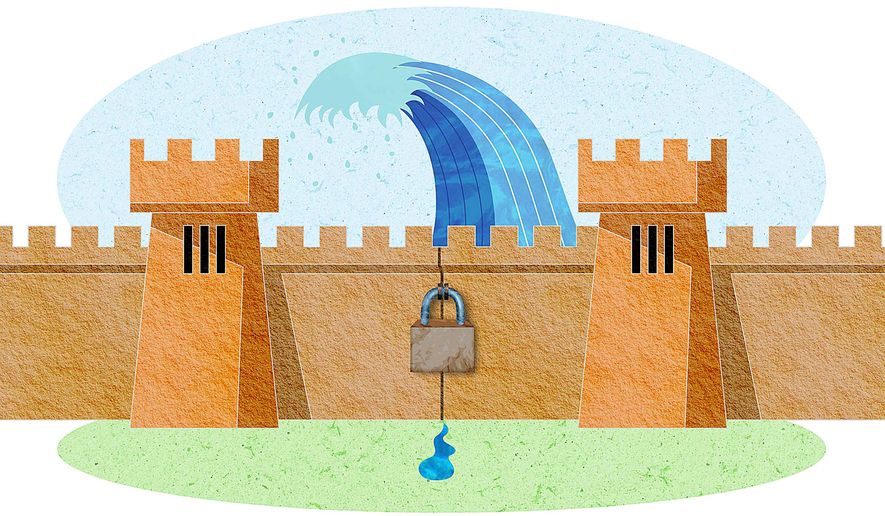OPINION:
A severe drought currently ravaging Southeast and South Asia has helped spotlight China’s emergence as the upstream water controller in Asia through a globally unparalleled hydroengineering infrastructure centered on damming rivers. Indeed, Beijing itself has highlighted its water hegemony over downstream countries by releasing some dammed water for drought-hit nations in the lower Mekong River basin.
In releasing what it called “emergency water flows” to downstream states over several weeks from one of its six giant dams — located just upstream of where the Mekong flows out of Chinese territory — China brashly touted the utility of its structures in fighting droughts and floods.
But for the downriver countries, the water release was a jarring reminder of not just China’s newfound power to control the flow of a life-sustaining resource, but also of their own reliance on Beijing’s goodwill and charity. With 14 additional dams being built or planned by China on the Mekong, this dependence on Chinese goodwill is set to deepen — at some cost to their strategic leeway and environmental security.
Armed with increasing leverage, Beijing appears to be pushing its Lancang-Mekong Cooperation (LMC) initiative as an alternative to the lower-basin states’ Mekong River Commission, which China has spurned over the years. The Lancang-Mekong Cooperation, a political initiative emphasizing Chinese “cooperation,” is intended to help marginalize the Mekong River Commission, an institution with legally binding rules and regulations. China’s refusal to join the 1995 Mekong treaty, which created the commission, has stunted the development of an inclusive, rules-based basin community to deal with water- and environmental-related challenges.
It was no coincidence that Beijing’s water release started shortly before the March 23 inaugural Lancang-Mekong Cooperation summit of the leaders of the six Mekong basin countries in Sanya, China.
The LMC project is also designed to overshadow the U.S.-sponsored Lower Mekong Initiative, which seeks to overcome Chinese opposition to the Mekong treaty by promoting integrated cooperation among Cambodia, Laos, Thailand and Vietnam.
The Mekong, Southeast Asia’s lifeline that is running at a record low since late last year, is just one of the international rivers China has dammed. It has also targeted the Yarlung Tsangpo (Brahmaputra), the Arun, the Indus, the Sutlej, the Irtysh, the Illy, the Amur and the Salween.
Asia’s water map changed fundamentally after the communists took power in China in 1949. It wasn’t geography but guns that established China’s chokehold on almost every major transnational river system in Asia, the world’s largest and most-populous continent.
By forcibly absorbing the Tibetan Plateau (the giant incubator of Asia’s main river systems) and Xinjiang (the starting point of the Irtysh and the Illy), China became the source of transboundary river flows to the largest number of countries in the world, extending from the Indochina Peninsula and South Asia to Kazakhstan and Russia.
Before the communists seized power, China had only 22 dams of any significant size. But now, it boasts more large dams on its territory than the rest of the world combined. If dams of all sizes and types are counted, their number in China surpasses 90,000.
China’s dam frenzy, however, shows no sign of slowing. The country’s dam builders, in fact, are shifting their focus from the dam-saturated internal rivers (some of which, like the Yellow, are dying) to the international rivers, especially those that originate on the water-rich Tibetan Plateau. This raises fears that the degradation haunting China’s internal rivers could be replicated in the international rivers.
China, ominously, has graduated to erecting mega-dams. Take its latest dams on the Mekong: the 4,200-megawatt Xiaowan (taller than the Eiffel Tower in Paris) and the 5,850-megawatt Nuozhadu, with a 190-square-kilometer reservoir. Each of them is larger than the current combined hydropower-generating capacity in the lower Mekong states.
Despite its centrality in Asia’s water map, China has rebuffed the idea of a water-sharing treaty with any neighbor.
Against this background, concern is growing among is downstream neighbors that China is seeking to turn water into a potential political weapon. After all, by controlling the spigot for much of Asia’s water, China is acquiring major leverage over its neighbors’ behavior in a continent already reeling under very low freshwater availability.
Asia’s annual water availability is barely one-tenth of that in South America, Australia and New Zealand; not even one-fifth of North America’s; nearly one-third of Europe’s; and a quarter less than Africa’s. Yet the world’s most rapidly growing demand for water for industry, food production and municipal supply is in Asia.
In the Mekong basin, China has denied that it is stealing shared waters or that its existing dams have contributed to river depletion and recurrent drought in the downstream region. Yet, by ramping up construction of additional giant dams, it has virtually ensured long-term adverse impacts on the critical river system. Indeed, with Chinese assistance, landlocked Laos also plans to build more Mekong dams in order to make hydropower exports, especially to China, the mainstay of its economy.
China is clearly not content with being the world’s most dammed country, and the only thing that could temper its dam frenzy is a prolonged economic slowdown at home. Flattening demand for electricity due to China’s already-slowing economic growth, for example, offers a sliver of hope that the Salween — which flows into Myanmar and along the Thai border before emptying into the Andaman Sea — could be saved, even if provisionally, from the cascade of hydroelectric mega-dams that Beijing has planned to build on it.
More fundamentally, China’s unilateralist approach underscores the imperative for institutionalized water cooperation in Asia, based on a balance between rights and obligations. Renewed efforts are needed to try to co-opt China in rules-based cooperation.
• Brahma Chellaney is a geostrategist and the author of “Water: Asia’s New Battleground” (Georgetown University Press 2013).




Please read our comment policy before commenting.